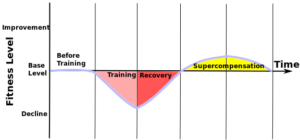Ever had that day when you’re smashing fitness goals for the week and you wake up sore, but with questioning yourself, “how can I possibly take a day off training?” Well, the first question I have for you is, did this happen overnight? Did you feel sore, tired and exhausted after one tough training session or have you been ignoring the warning signs of what possible could be, overtraining, as a result of inadequacy?
While some of you reading might possess the stamina and endurance of athletes, but for those who haven’t reached there yet, I’m here to tell you that taking a day off from your training is OK.

Using the graph above to illustrate, let’s talk a little science first. Our fitness levels can be broken down into four stages – initial fitness, training, recovery and super-compensation. The first section on the graph is our initial fitness period: the base level we start at (beginner, intermediate, et al), then during training (the second section) fitness level declines as the muscle start to breakdown and deplete. We then enter the recovery phase where we start to rebuild ourselves back to the base fitness level, where we were first at. Now, mentally, because we have recovered and we know are bodies are pretty clever in adapting, we start to adapt ourselves to a higher level of fitness – the moment when we’re ready for the next workout – which then inadvertently puts us into the phase of super-compensation. You may recognise this phase through more reps, heavier weights or more intense exercises that you feel you’re capable of. This then goes to show that if our bodies don’t go to the recovery phase, our fitness levels revert back to the base line or even below.
You don’t have to be an athlete to overtrain. The first warning sign to show that you need a recovery day is a definite drop in energy levels; that stage where we can’t estimate the importance of other valuable facts of life, such as work, kids, family, social life, nutritious food and a decent sleeping pattern. Other signs, you may notice are:
- You experience ongoing soreness in your muscles or joint pain, recurring injuries.
- Headaches, frequent colds (low immunity) or not sleeping.
- You experience a sudden drop in training capacity or not feeling so enthusiastic about your next session.
- Your workouts are inconsistent – you feel amazing one day and then the next you feel sluggish.
Many people believe that by pushing through yet another workout, they will get stronger and the pain they’re experiencing is part of the deal. Not always true.
We can break the soreness down into three different areas – MILD, DOMs and Injury.
Mild soreness:
It is not unusual to experience mild muscle soreness the day after a good workout. This is generally related to the tearing caused to the muscle and can last for a day or a couple of days, if you are a beginner. This is usually the ‘good’ kinda soreness, as it puts us into that “adaptation” phase which is important for increasing fitness and strength.
DOMS – Delayed Onset of Muscle Soreness
This soreness although not completely understood is thought to be ‘micro trauma’ or very small-scale damage, cause by eccentric (lengthening) of the muscles exercised. The muscles feel stiff and most sore 24-72 hours after the exercise.
Injury-related
Often this type of soreness is sharp, especially when you are in a particular position, or move a certain way. When this occurs you should always follow the RICE principle (Recover, Ice, Compression and Elevation), as well as book a visit to your health professional. Remember an injury does not always rule out training. Exercises that work around the injured muscle are possible to move,; for example, doing upper-body workouts when you have a hamstring or calf injury. It does depend on the severity of the injury, of course, but hey if you are listening to your body in the first instance it may not get to this point.
Some tips on how to avoid overtraining and to aid recovery:
- Keep a training diary that records the number of sessions, rest days, how many hours you are sleeping and also your nutrition.
- Schedule a rest day which may include a massage, stretch class or meditation, even just a light walk if you can’t possibly sit still for an hour.
- Use the foam roller at the gym on a regular basis.
- Get enough sleep.
- Change the frequency, intensity and type of training you are doing to notice change.
Remember recovery can also depend on the activity you are performing, i.e. if you love your fast-paced walking everyday, this may not necessarily require a long period of rest. Especially when compared to someone who lifts fairly heavy weights everyday.
Not taking a rest day is one of the fastest ways to guarantee an injury and a decline in strength and speed. When planning your workouts for the week out ahead, make sure you allow a rest day or two, depending on the intensity and type of training you’re doing.



Recent Comments